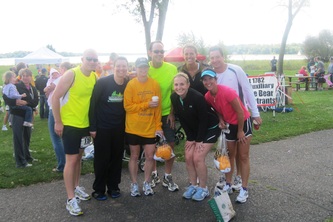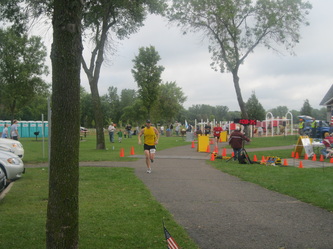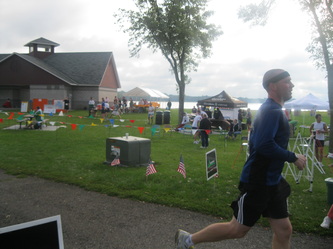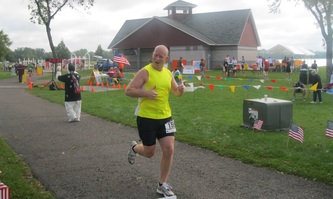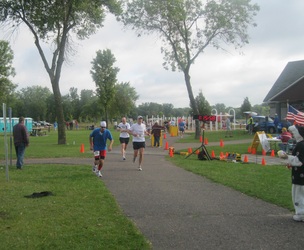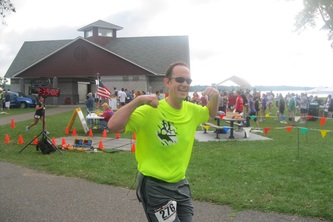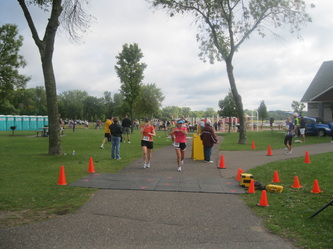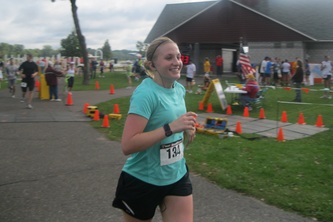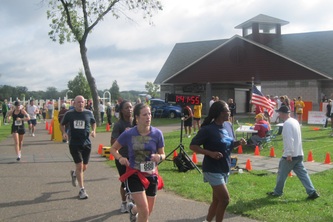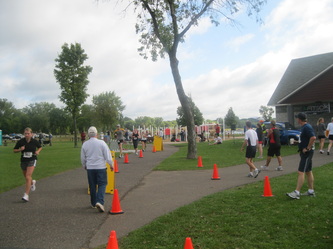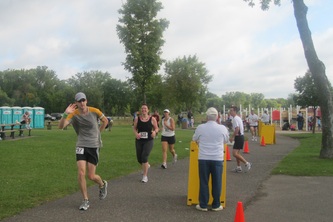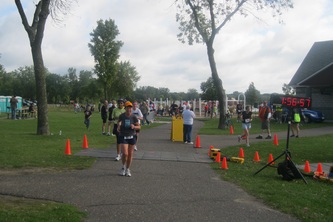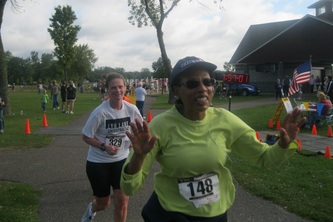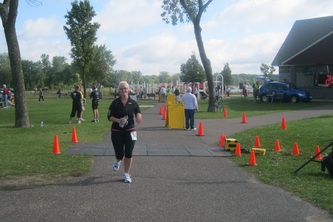Hey Everyone - Welcome to the spring Southdale Y Run Club! Most of us are training to run a half-marathon at some point in June...but there are several folks that are planning on running Grandma's Marathon!! This is a great time to be running outside, especially if we can ever get rid of all of the snow and ice...maybe that will finally happen this weekend! I will do my best to keep this site updated with our meeting locations for long runs and a link to maps of the route we'll be running...if you haven't run our scheduled route before it's sometimes helpful to check out the map before you head out. I would also encourage everyone to create a training log at http://www.dailymile.com This is a great site that allows you to track your miles while giving and receiving some extra motivation and encouragement along the way. Several of us are already regular users of dailymile including: PJ - http://www.dailymile.com/people/peichtenChris - http://www.dailymile.com/people/roltymanAnne - http://www.dailymile.com/people/mplsanneAlayna - http://www.dailymile.com/people/alaynadavisBecca - http://www.dailymile.com/people/runtherace76Sheri - http://www.dailymile.com/people/slk424Tanaegh - http://www.dailymile.com/people/TanaeghMeredith - http://www.dailymile.com/people/MeredithO2Have a great week! Becca:-)
You've made it to the taper weeks!!!! Time flies when you're having fun I guess because it seems like just a few weeks ago we were starting out with our first long run of 6-7 miles...and now we're going to back to our long run being 10 miles this week and 7 miles next week!!
The next few weeks are going to seem slightly strange because in your head you'll be thinking that the marathon is happening in just a few weeks...shouldn't I be running more?!?!? BUT...if you take this next few weeks to "rest" your body will thank you and it will truly make your marathon experience that much more enjoyable!!! Enjoy the fact that you don't have to spend hours and hours per week running! Hang out with your family, go for a walk, sit outside and read a book, enjoy yourself...the next few weeks can be a lot of fun! (Besides, it's not like you're going to be sitting around doing NOTHING! We've still got run club with some hills and sprints for old times sake, a couple of more "long" runs and some shorter runs in between!!)
I uploaded the pictures from the Bear Water Run! Felipe did a great job at capturing most everyone going around the first lap and we got part of the group in a "group" picture.
Have a great week everyone! I will see you on Satruday morning!
Becca:-)
Can you believe we only have three “long” runs left before the marathon?!?!? I know there are a few more Saturday runs beyond Sept. 11…but 10 miles is going to be a piece of cake after running 20!!
PJ has said it a few times, and from my personal experience I agree, that the next few weeks are probably the most challenging. We’ve been training for a couple of months now and our bodies are getting tired…but we’ve still got another six weeks until the big day, and a 17, 18 and 20 mile run, and that’s a little too much to feel like the finish line is just around the corner.
Here’s the thing though…it really is all worth it…and in the end, if you can run 20 miles…you really CAN run 26.2! I had a hard time believing that last year…6.2 miles seems like a lot of “extra” miles to run on race day! I would be lying if I said the last 6.2 miles easy. Quite honestly, they are pretty darn difficult!! By the time I got up the big hill somewhere around mile 20-21 my foot was killing me and I was beyond exhausted…but by that point none of it mattered…
When I got up that hill I also knew that I only had 6.2 miles left to finish my first marathon! I knew I could go 6.2 miles, even if I had to walk it all (which I didn’t!) and there was nothing that was going to stop me from finishing. The crowds cheering for you on Summit Ave are AMAZING!! There is nothing more motivating then having thousands of people cheering and telling you that “You can do it!!” Yeah - the last 6.2 miles of my first marathon were probably some of the hardest physically that I ran all summer, but I can honestly say they were the also the best 6.2 miles that I ran all summer!!!
Hang in there for the next few weeks! I am already excited for marathon weekend because it was such a great experience for me last year!
· I LOVED the Expo…walking around with tons of other runners and getting free stuff! Make sure you plan some time to walk around and look at everything.
· I LOVED getting up on race morning…I was so nervous I thought I might be sick, but it was the best kind of nervousness possible!
· I LOVED waiting for the starting gun with thousands of other people…someone in one of the apartments was cooking bacon too and it smelled AWESOMEJ!
· I LOVED the first few miles of the race…I literally didn’t even feel like I was running I had so much energy!
· I LOVED the cheer zones along the race course…people are pretty much throwing huge party just to cheer for you!
· I LOVED seeing my family at various points along the course…they made it easier for me to keep going!
· I LOVED it when I made it to the top of the big hill somewhere around mile 20-21…I had to walk some of it, but when I made it I knew there was nothing left to stop me from finishing.
· I LOVED making it to the top of the final hill on Summit Ave and looking down the hill to see the crowds, the massive American flag, and the finish line…there are not even words to describe how I felt at that moment!!
· I LOVED crossing the finish line and knowing that I HAD DONE IT!!!! I was exhausted…but all wanted to do was find PJ so I could give him a huge hug and start celebrating!!!
· I LOVED that as we were all walking away to our cars I got to take a picture of the bus on the big TV screen…’cause that meant all of us that had worried about getting picked up by the bus had no cause for concern!!
· I LOVED wearing my Twin Cities Marathon Finisher shirt after the race…I still like to wear it!! J
· I even LOVED being so sore for the rest of the week after I finished!!! It’s a great story to tell when someone is asking why you’re walking down the stairs backwards!! J
I could probably keep going…but you get the idea! In just a few short weeks and you’ll be able to make your own list of things that you loved about your marathon experience…and running the 17, 18 and 20 mile long runs will just seem like a distant memory!! J
This is going to be a long post - but it's not my words. This following is a story from a book I have - The Non-Runner's Marathon Training Guide. It tells the story of Mark Block and seems fairly appropriate considering we're reaching the 15 mile distance this week...It's a super long story (and as a communications person I saw about a hundred ways they could have written it better), but it's a pretty inspiring s if you have the time to read it!
Mark Block’s Story
The Non-Runner’s Marathon Trainer by David A Whitsett, Forrest A. Dolgener and Tanjala Mabon Kole
A high school track star in both cross country and the 2-mile, Mark set track records in the state of Iowa that stand to this day. After high school, he went to the University of Northern Iowa on a cross country scholarship, and between two workouts routinely ran 14 miles per day. After his first year of college, Mark began questioning the direction he wanted his life to take. So, at the age of 20, he decided to enlist in the Army rather than return to college in the fall. To keep himself in condition during the summer, he ran on the river roads near his hometown of Fort Dodge. Two days before he was to leave for boot camp, his whole life changed.
It was August 3, 1986. He and a friend were driving down a road that had only recently been reopened after construction. Mark planned to take a run on that road the next day and he wanted to scope it out ahead of time. It was late – 2 a.m. They had not been drinking. They zipped through the darkness reminiscing about their night and their friendship in preparation for Mark’s departure.
Suddenly, they missed a turn in the road. The small car Mark was driving went into the ditch and flipped several times. Mark was not wearing a seat belt. As the car flipped, Mark was thrown through the windshield but stopped by the metal of the hood and engine as they crumbled in front of him. The car continued flipping until it smashed into a tree and stopped. Both men lay unconscious.
After the friend regained consciousness, alghough dazed and disoriented, he managed to crawl out of the car and walk to a farmhouse for help. Shortly after, a 911 call went out to the volunteer paramedic squad to respond to a one-car accident in which there was one fatality. The coroner was notified
When the paramedic arrived they crawled inside the car but could not located a pulse on mark. Although all initial indicators pointed to his death, they started resuscitation efforts and to their surprise managed to get a pulse. As quickly as possible, Mark was stabilized at the scene, extricated from the car, and transported to the nearest hospital
A CT scan revealed head trauma, a broken neck, and a partial cut of the spinal cord. As the trauma of the injuries settled in his body and swelling increased, his condition worsened. He needed more sophisticated care than the local hospital was able to provide. In grave condition, he was airlifted by helicopter to Des Moines. En route, Mark suffered cardiac arrest. The transport team managed to revive him, but things looked very bleak for him as the helicopter landed.
For the next several days, Mark’s condition continued to deteriorate. As the swelling around his brain and spinal cord increased, spinal shock set in and he stopped breathing. He was resuscitated again and hooked to a respirator. He had shattered his second, third, fourth and fifth vertebrae and desperately needed surgery to repair them and the cut in the spinal cord. But his condition was so tenuous that he would not have survived the surgery. For two weeks he lay in a coma paralyzed from the ears down with a respirator breathing for him.
When surgery could finally be performed, the vertebrae were so badly damaged that they could not be repaired – only realigned and reinforced. For the next month, Mark lay paralyzed from the neck down, respirator dependent, and extremely disoriented due to the severe head trauma.
It was at this point that Mark started the recover process. He remembers it this way:
You wake up and you’re surrounded by people of authority, doctors and nurses, telling you what you can’t or won’t be able to do: “you’re paralyzed from the neck down, we’ll have you in the hospital for three to four months, and when you leave you’ll be in a wheelchair – hopefully, an electric wheelchair if you can regain some use of your hands. You’ll require assistance in all activities of daily living; basically you’ll be totally dependent on somebody else.”
At that point in time, once I came out of the coma, all I could do was lie there. I couldn’t do a thing. My lungs were gone. I couldn’t talk above a whisper. Anytime they’d try to sit me up I would pass out.
That was the crucial moment, for me. Being totally out of control of myself; being totally dependent on others. It was terrifying. The fear of living that way the rest of my life motivated me. I remember thinking, “What do I have to lose?” I turned the energy of fear into the energy for recovery.
If I would have listened to all those people telling me what I couldn’t or wouldn’t do, then I wouldn’t have even tried. I remember thinking, “Well, if that’s the way it turns out then I’ll accept it and live with it, but that doesn’t mean I’m not going to try”. Don’t get me wrong, I’m not saying I knew more than those people. They’re wonderful professionals and when you are in that type of situation, you need them. But all they wanted to see were the probabilities – not the possibilities. By focusing on my limitations, they were limiting me. And I fought against it.
Mark refused to accept the prognosis offered by the medical staff and informed the doctors that when he left he would walk out. It was nothing they hadn’t heard before from other people with similar injuries. Denial and unrealistic optimism were common initial reactions in cases such as Mark’s. A psychiatrist was added to Mark’s medical team to help him accept the reality of his situation and prepare him for the normal recovery process with spinal injuries. What happened next was anything but normal.
Mark’s recovery process started with him unable to move or feel anything below his ears. His goal was to walk again. The only major part of his body that still seemed to be working was his brain. So that’s what he started exercising first. He began with what he referred to as kinetic visualization. Although at the time he could not get his body to walk, he could walk in his mind. He practiced remembering what it felt like to walk. He lay in bed and visualized feeling his legs, his feet, how it felt to pick up first one leg and then the other and feel the pressure of the ground as it met each foot. Like an athlete mentally rehearsing a performance, Mark mentally practiced moving his fingers and toes. It was a mental process of kinetic reeducation by which he hoped to reconnect the neural pathways running from the brain to the intended muscles. As Mark puts it, “I still had the control center – my brain. It was just a matter of getting the connections going again…finding the “phone lines” that were down and getting them hooked up again so that the message could flow through. I would lay there and visualize something as simple as moving a finger or toe.”
The first thing Mark moved was the big toe on his right foot. The nurses told him it was a spasm, and that he shouldn’t get too excited about it. Besides, they added, that would be impossible since recovery of movement in cases such his always happened from the neck down. But at Mark’s insistence they went and got the doctor. He, too, said it was a spasm. At Mark’s request, the doctor bent directly over the toe in order to watch very carefully…and Mark nearly kicked him!
Initially, movement was not something Mark could repat at will, but it was a start. As Mark puts it:
You start with just a little flicker, and you make it grow through reeducation and increased range of motion. I was able to move before I was able to feel. I could move the toe, but I couldn’t feel it. The more I moved it, then the feeling started coming back. Once that happened is when things got really painful, because it felt like pins and needles. But it felt good, because it gave me reference points. When I first started, I couldn’t tell where my arms or legs were – there was just dull pain from the neck down.
Victories were found in reclaiming the ability to do the simplest things. Going from being flat on his back to being able to sit up with passing out took months. Being able to hold a spoon or a glass meant the difference being dependent on others or being able to feed himself. Being able to push the elevator button was a huge step! Mark reflects:
Think about the activities of daily living…the things you do and just take for granted. Like brushing your teeth, being able to feed yourself. There are just so many things involved with doing anything – it’s never just an all or nothing situation.
When you are surrounded by people constantly telling you, “No, you can’t do that,” there comes a definite point where you have to make a decision, “OK, I’m going to go for it and do it, or I’m going to believe what they tell me and accept my limitations.” It’s up to you. Are you going to accept the limitations they are putting on you through their beliefs, or are you going to find out for yourself what you may or may not be able to do?
After awhile the doctors threw up their hands in exasperation, and left Mark alone to do it his way. And he did just that. He set his own recovery goals and charted his physical therapy course. Some days, Mark would stay in physical therapy all day. With hard work, prayers, resisting the negativism of others and staying focused on the goal, Mark surpassed everyone’s expectations (except his own) and on Christmas Day walked out of the hospital with only a cane for support and a person on either side for stabilizing.
For the next nine months, Mark lived at home and worked a desk job in the family business. That spring, he helped coach the track team at his old high school He really enjoyed being around the kids and the running again, even though he was still dependent on a cane in order to walk.
One year after his accident, Mark returned to the University of Northern Iowa to resume his studies. According to Mark, that was a very good decision but a very difficult adjustment. Needing the cane in order to be mobile made this 22-year-old former track star extremely self-conscious, and adjusting to college life as an independent adult in his current condition was an extremely difficult transition for him. It was the transition he wasn’t handling very well until the day he read an article in the university newspaper about a class which was to be offered the following semester called the “Marathon Class.” An informational meeting was being held that week for all interested persons.
The minute he read about it, he knew that this class was just what he needed. He needed a structured mental and physical challenge of this type to help him get his self-confidence back. He just had to get into that class.
He left for the meeting way ahead of its scheduled start time. He wanted to be there before others started arriving so that he wouldn’t feel embarrassed when he walked in with his cane. As he parked in the handicapped parking area nearest to the meeting site, he became more and more frustrated with the situation. What was he doing? How could he expect to run a marathon when he couldn’t even walk 20 feet without a cane? This was absolutely ridiculous! This just wasn’t possible given his limitations.
Suddenly, the irony hit him like a lightning bolt. Here he was doing to himself what he had perceived his doctors and nurses doing to him in the hospital: accept your limitations and learn to live with them. Because he hadn’t accepted it then, he was walking when he should have been in a wheelchair. And if he didn’t accept it now, who is to say that he wouldn’t find a way to do the marathon? He was going! He reached for his cane…and stopped. “Screw it,” he thought. “I’m not walking into a marathon meeting with a cane. If I can’t get there without it, then I don’t belong in the class.”
Staggering 20 feet at a time, Mark inched his way the few hundred feet to the meeting site by balancing himself against the outside of buildings and the walls of the hallways. He barely made it in time to find an empty seat. By the time the meeting started, the room was packed. There were over 80 people there hoping to get into the class, but fewer than half that many available slots. The instructors, Forrest Dolgener and David Shitsett, explained the class requirements: Students would train for and run a full 26.2 mile marathon. You either finished or you didn’t. If you finished, you got an A; if you didn’t, you got an F. Training was provided for both physical and mental components. If you followed it, you would finish. If you didn’t follow it, you wouldn’t. It was that simple. Only those who were serious should stay; once you were in the class you were committed.
Most people stayed, including Mark. Thirty names were chosen from the hat. Mark’s was not one of them After the meeting ended and the room started to clear, Mark stayed behind hoping to talk with the instructors to see if they would reconsider letting him in. He told them briefly what he had been through.
“Can you run at all?” Dave asked him.
“Well, not yet,” Mark replied.
“What’s your current level of activity?” questioned Forrest.
“Right now, I can walk about 20 feet without having to stop,” answered Mark.
Dave looked at the young man standing in front of him. He remembered Mark from his year of collegiate cross country, and now knew why he hadn’t been back to team since. If this young man, who wasn’t even supposed to be walking wanted to try a marathon, he sure wasn’t going to tell him no. After consulting with Forrest, Dave told Mark, “Here’s what we’ll do. You go home and think about it overnight. Tomorrow, if you still want to try this, be in my office at 2:00 and we’ll talk more about it. OK?” “OK,” beamed Mark. He didn’t even need to think about it – he’d be there.
It was a few minutes after 2:00 and Dave was starting to wonder if Mark had reconsidered, when he heard a strange sound coming down the hall. Unable to place the step-slap-drag sound, he listened as it slowly approached his office. When it stopped, there stood Mark in his doorway loaded down with what appeared to be files of paperwork.
“I’d started to think maybe you weren’t coming,” Dave teased.
“Couldn’t find a handicapped parking place, so it took me a little longer to get here,” Mark said, smiling.
“What do you have there?” Dave asked, nodding at the stack of papers mark was trying to balance in his free arm.
“Medical records,” Mark replied. “Thought I better bring them in case you had specific questions about my condition.”
As his guest sat down, Dave looked at the huge stack of paperwork Mark had just deposited on his desk in wonder at all this young man must have gone through. Over the next hour, as the details of Mark’s story unfolded, Dave’s respect and admiration for Mark’s determination deepened. While he had concerns about how Mark would hold up under the physically demanding training, he certainly wasn’t going to deny Mark the change to try after all he’d come through to get to this point.
Through the course of their conversation, it became clear to Dave how important it was to Mark that he be measured by as many of the same criteria as possible as were expected of the rest of the class. Mark needed to have an A or F goal just like the rest of the students, although an entire marathon in just one semester of training was clearly unrealistic for Mark given his present level of activity. As a way to test the waters Dave said, “Well, you know we’re not going to let you off easy.”
“Good! I don’t want you to…that’s why I’m here,” Mark answered with a sense of relief. He was so tired of everyone tryint to impose their negative limitations on him, that being challenged is exactly what he needed and hped he would get from Dave and Forrest.
“I’ve thought about this, and I’ll you in the class, but we have to decode on what would be a reasonable goal. If you’re not able to run, can you walk?” Dave said.
“Well, yea, I’ve walked two miles, but with lots of stops to rest,” Mark replied.
After some discussion about realistic but challenging goals and possible alternative training methods, the two agreed that Mark’s goal would be to walk a 10K (6.2 miles). He would train with the rest of the class, and while they would run, he would walk. Dave recalls:
So, we sent Mark home with the same pre-training instructions s all the other students: by the time the semester began in mid-January they had to be able to jog (or, in his case, walk) for 30 minutes without stopping in order to be ready to begin the formal training.
On the first day of class we met in the UNI-Dome (the University’s indoor stadium), and they all did it…including Mark. A leg brace had replaced the cane, and he was very unsteady. He dragged his right leg with every step and was very slow, but he did it.
From then on, every Saturday when we took the class out for their long run Mark was there and he walked over the same course that everybody else ran. We adjusted his distance commensurate with his goal, but he was on the road for at least as long (usually longer) as the rest of the class.
Under Forrest’s supervision, Mark cross-trained by lifting weights and riding a stationary bike. But for Mark, the main thing was the walking and he pushed himself – occasionally beyond his capabilities. There were a few times when he got himself in trouble:
I would walk on a straight road out into the country, so that there was only one way to get back and that was to walk back. Often on the way back my legs would start shaking so badly I would have to stop and stretch and rest before I could continue. One time I walked out so far that I couldn’t make it back. I had to stop at a farmhouse and ask for help. They must have been able to tell I was in pretty bad shape, because they gave me a ride back into town.
At mid-semester, the class did a 13 mile run – a half marathon – as a kind of mid-term progress check. As usual, everyone started together that morning and headed out into the country for the out-and-back run. Afterward Dave and Forrest sponsored a get-together for the class with soft drinks and sandwiches to celebrate their accomplishment. As Dave remembers:
We were all sitting around talking and laughing when somebody asked where Mark was, and I realized that he hadn’t come back yet. It was getting pretty late and I started to get worried because he should’ve been back by then, so I drove out along the course we had used that day to check on him.
When I found Mark, he was on his way back and extremely tired, but still walking. I pulled up alongside him and said, “Mark, what are you doing? It is almost noon!”
“Well, I’m not done yet,” he replied
I asked him to tell me where he’d walked. As he described his route, I mentally calculated his mileage. “Mark, that’s seven miles!” I informed him. “Get in the truck…you’re done for the day,” I laughed.
As we headed back into town, I said smiling, “You know that this means, don’t you?”
“What?” Mark asked.
“Well, you just walked your final exam, so you’re going to have to increase your goal. Do you think you can do 10 miles?” I challenged.
“Well, I don’t know,” he answered.
“Good, let’s do 10 miles then,” I said. And that became his new goal for the marathon, and he continued to train with the rest of the class.
As the marathon approached, Mark got excited and nervous. He was going to be walking among hundreds of runners down the streets of Iowa’s largest city. What if something happened? And yet, he felt that he could do more than goal. He talked with his parents about it and they encouraged him to just walk his 10 miles and get his A for the class. The high school team he had helped coach during his year of recuperation was there for the Drake Relays and they encouraged him to do the same. Suddenly he felt he was being confronted by the same limiting attitudes he had been working to beat since his accident. And it made him mad. He decided he was going to do 13.1 miles…if everyone else was doing a marathon, he would do a half-marathon. When he informed Dave of his decision, after first reminding Mark that his goal was to do ten, Dave added, “But if you want to do 13, great. Go for it!”
They decided that Mark would start at the half-marathon point, and walk to the finish line. After everything was in place, Mark started telling people that he intended to walk 13.1 miles. Everyone encouraged him to just stick with the first goal of 10 miles and get his A. But as Mark explained, “They missed the whole point. I wasn’t doing this for the grade. I had taken this class as a challenge to better myself.”
Later that night, Mark decided that he wasn’t going to start a mile 13 after all. He was going to start at mile 11, and walk 15 miles. In all honestly, Mark wasn’t sure he could make it that far, but he decided he would either defy all expectations, including his own, or fall flat on his face trying. Mile 11 it would be. He told no one, except for a new friend from Des Moines, Bill Kunz. After reading Mark’s story in the local newspaper, Bill had contacted him with a request to meet him and help him in any way possible. A wheelchair user himself, Bill had a special empathy for Mark and what he was trying to accomplish.
The next morning at 7 a.m. (one hour before the official start of the marathon), Mark met Bill and another friend, Carol at mile 11. With Bill cheering him on, and Carol walking with him, Mark being his “marathon.” Before too long, the leaders caught and passed him and sometime after that the fastest of the class members caught up to Mark and passed him as well. Pretty soon, Dave Whitsett, who was running the marathon along with the class, came running up beside mark. “How are you doing,” he asked. “Great,” Mark answered. Dave looked at his watch and looked at mark. “Where’d you start?” he asked. Mark only smiled. Dave knew something was up, but he didn’t say anything. He just smiled at Mark before he pulled away. Hours later, Mark was still walking. He remembers the last few miles this way:
Most of the course was closed up. The water stops had been taken down. Traffic control had been terminated. Normal traffic had resumed and cars were flying by me; people were yelling at me to get off the street not realizing I was in the marathon. Most of the other runners had finished hours before. I’d already been walking for eight hours. I was getting dehydrated, weak and wobbly. My legs were really aching. Carol was still walking with me, and the pastor form the student center on our campus had come to help me, too. At this point, he was driving ahead of me helping to control traffic at the intersections so that I didn’t have to stop, plus he brought me water which was a big help because I was starting to get dizzy from dehydration.
When I got to the last mile, some of the people from the class were still there to cheer me on. At Dave’s insistence, the marathon officials had kept the finish line setup up and were there waiting for me. As I walked that last mile, my family and friends and some classmates walked with me to show their support and encouragement. By that time I was so fatigued that I had to concentrate very hard just to keep going. I had to consciously think left, right, left right to keep my legs moving…since the accident, walking had never been an automatic thing – every step required deliberate thought. It was getting really tough. My legs were continuing to shake and wobble, I was getting nauseated from dehydration, and my whole body was tingling from fatigue. But I could see the finish and there was no way I was not going to finish. Even if I had to crawl, I was going to cross that finish line.
It took me 8 hours and 33 minutes to do it, but I made those 15 miles and got my medal. Afterwards, Dave came up to me and asked, “How far did you go?”
“Fifteen miles,” I said.
He gave me a look that seemed somewhere between reproach and happiness and, for a second, I didn’t know if he was going to knock me out or hug me! Then, with a huge grin on his face, he proclaimed, “Fifteen miles!” and gave me a big hug.
“Yeah, I knew if I started there, I’d finish,” Mark explained. “There was no way I wasn’t going to finish.”
Still smiling, Dave told him, “I knew something was up because when I passed you, I knew you should’ve been further along if you had started where you were supposed to. Fifteen miles! Congratulations Mark.”
In retrospect, Mark had this to say about the whole experience:
The moral of my story is that you never knew what you can do until you try. If you listen to what others say, you may not try at all. If you listen to your body, you may quit too soon. What your mind believes, your body believes. Your mind is the key.
I gained so much confidence from that class. Here I was caught in this mode of everyone telling me what I couldn’t do. I can’t tell you how many times I heard, “Accept your limitations…this is the way you are and you just have to deal with that.” And then you go into something like this class wehre people are telling you what you can do if you set your mind to it. It was awesome! It was exactly what I needed. I wish more people would do that – focus on the possiblites, not the probabilities. That’s what Dave and Forrest do in the class. They don’t tell you what you can’t do…they guide you through what you didn’t know you could do, and with their help, you do it. The class is about a lot more than just running a marathon. It teaches you a different way to think – about yourself and your goals. It’s really about life and hot to really live.
Now 32 years old, Mark is happily married and has a young daughter. He travels regularly as a sales associate for a medical supply company. He no longer needs a brace to walk and is able to run short distances.
CONGRATULATIONS to everyone for finishing their first half marathon, or running their longest distance ever, or having a PR, or reaching some other goal that you set for yourself!! The weather was wet...but I'll take the rain over the heat and humidity:-)
We'd love to hear how the Minnesota Half Marathon runners did! The Urban Wildland was a great race...although I really do think they need to get some Nut Rolls at the finish line!! :-)
Have a great weekend!
Becca:-)
Two years ago today I met PJ for the first time. (Yes, I remember the dateJ) At the time, I weighed about 40 pounds more than I do now and I was extremely out of shape. Exercise, in any form, was really not a part of my life…even though it was something that I wanted to do I could never seem to get past the first few weeks of a new exercise program.
I reached a point where I knew I needed to do something. I went to the YMCA, where I was paying for a membership that I hadn’t used in months, and signed up for the introductory personal trainer package. I thought that maybe if I found someone to help me get started I would be able to keep going for longer than a few weeks.
On Aug. 6 2008 I went to the gym to workout with PJ for the first time. I remember he had me do the Arc Trainer…which I hated ‘cause my lungs burned so badly; lunges down the hallway…which made my legs so sore it hurt to walk for several days afterwards; and planks…which I had never even tried before and couldn’t do for more then 10-15 seconds…I was in bad shape.
When I started this new workout plan it wasn’t with the specific idea that it was so I could begin running…that seem so far beyond my capabilities that I really didn’t even consider it. For some reason though, I told PJ on that first day about how I had always wanted to run a marathon…and he looked at me and said “Well, why can’t you?”
Even though that still makes me smile, because at the time I honestly thought he was either being patronizing or just plain silly…I realize now that he honestly just believed that there was no reason I couldn’t do it, as long as I took the time to work towards the goal.
In September I ran around Lake Harriet for the first time without walking (2.8 miles). In December I ran my first 5K. In June I ran my first half marathon. And on Oct. 3, 2009 I realized my long time dream of running in, and finishing, my first marathon!!!
Running has changed my life! It has helped me through some tough personal times and has shown me that just about anything is possible if I am willing to work hard at making it happen. Training for my first marathon taught me so much about myself and about life in general…and I generally had a blast doing it!
Training for my second marathon has not been quite as much fun. I’ve had a tough summer physically. I feel like I’m getting slower and slower…something that doesn’t sit well with my perfectionist personality…and I have been quite close to just throwing in the towel several times in the past few weeks.
But…besides the fact that I don’t think I have it in me to just quit…I am reminded today, as I look back at the past two years, that running is about so much more for me than getting faster. Running for me is doing something that I truly enjoy… something that I physically couldn’t do 24 months ago. It is about persevering through the bad days and knowing that they will make the good days seem that much sweeter when they come. It is about the great friends that I’ve met and the awesome experiences that I’ve enjoyed.
I have no idea what’s going to happen in the next 8 weeks. I could end up with a migraine every week or not have another one until after the marathon (that would be a miracle, but you never knowJ). My goal though for the next 8 weeks is to just keep moving forward, and remember how much I really do enjoy the experience of running. Besides…more people than not think we’re all crazy for even trying to run a marathon…and I think that just makes this whole experience all that much more fun!!! J
In order to be a "blog" writer you need to 1) make sure you have interesting stuff to write about and 2) assume that people want to read what you're writing about.
The past couple of weeks I honestly haven't enjoyed running all that much (except for getting to know all of you) and that's made it hard to write about running...at least in any sort of positive way J
And while I've heard from several people that they have enjoyed reading my blog...I definitely do not assume that people want to spend an entire 16 weeks reading about me....and so I thought that this would be an awesome opportunity to get all of you involved in this writing experience...
I would love to hear your running story...
Why do you run? Why did you decide to join the Southdale Y Run Club to train for the Twin Cities Marathon in 2010? What is driving you to spend hours and hours training to do something that most people think is impossible or insane?
You can write a couple of sentences or a couple of pages...there's a "Comments" section below you to add your reply. I can't wait to see what everyone has to say!!! (And if no one replies then maybe there really isn't anyone reading this…and I won't have to worry about whether I have stuff to write about in the future – LOL - J)
Becca
Hey All –
I thought I’d provide my response to Grace’s question as this week’s blog…since I’ve been dealing with some of the same “fear” of sprints/hills. I don’t have any great answer, but I can share what I’ve been thinking about recently on the same topic.
The idea of pushing myself so hard that I "can't" breathe has always been hard for me to deal with...it really doesn't make sense to me that I would want to make myself feel uncomfortable.
If I rewind to less than two years ago, I couldn't "run" more than 1 or 2 minutes without feeling like my lungs were going to explode..."uncomfortable" doesn't even describe how I would felt. I would try it, get uncomfortable and then quit…no running for me.
Then a few weeks into my thousandth time trying to start running I had one of those "light bulb" moments. I was walking around the lake trying to get up the guts to try and "run" again...I was literally having a conversation with myself in my head...
"I need to just start running...I know the only way I’m going to get better is if I just keep pushing and start running."
"Ugghhh...but I HATE this...I hate not being able to breathe and I'm going to look like a big lug trying to pretend that I'm running..."
“But if I don’t at least try this is never going to happen…all I have to do is just start and try and run for a few minutes…”
…and on and on and on.
Throughout this internal dialogue a guy was walking in front of me at the same pace. I couldn’t get past him without speeding up, but he was so close I couldn’t walk fast enough either…annoying!! I stayed behind him for like five minutes, until I finally got so frustrated I just started running…and ran for 12 minutes straight without stopping!!!!
When I finally had to slow down and walk again, I was ecstatic!! I could barely breathe by that point, and I was definitely NOT feeling comfortable in any way…but I was still moving…and within a couple of minutes I was feeling fine again!!
I realized on that day that feeling uncomfortable didn’t need to stop me from running. Being out of breath wasn’t the end of the world and I really was capable of doing more than I ever thought possible! Within a month I made it around the lake without walking and within a year I had run my first marathon.
So you may be thinking…Great story, Becca…but you said that you’re struggling with fear of sprint/hills. What’s up with that?
Well, I wish I could say that once I learn something I am set for life, but unfortunately that’s not always the case…sometimes I need to learn things a few times over…and over and overJ
I know I can run now. Running a 10:30 to 11 min pace is “easy” and I really don’t have to push myself that hard to do it. I want to get faster, but in order to make that happen I have to be willing to push myself harder…and that means that I have to make myself feel uncomfortable again. Ugghhhh…I hate not being able to breathe!!!
Thankfully this time I have my experience from the past two years to draw upon. I know that for me I just need to take the “leap of faith”, push myself hard, and remember that which does not kill me makes me strongerJ I tried it this week during our sprints… I could barely breathe at several points throughout the run…and I was definitely NOT feeling comfortable in any way…but when we finished I was still able to move and I felt fine soon thereafter!! I actually really enjoyed the feeling of knowing that I had pushed myself hard.
One of my favorite books is one that PJ gave me when I first started running…The Courage to Start by John Bingham. There’s a section that I think expresses how I feel about this topic…and he does it in a much more eloquent way than I ever could.
“For non-athletes, the sensations of effort – the pounding heart, the burning lungs, the fatigue – are viewed as warning signs. In many cases they are warning signs. As one gets farther and farther away from any kind of conditioning and fitness, those physical sensations of effort become almost constant companions.
As a non-athlete I sought out every possible alternative to avoid effort. I paid whatever price was necessary to be able to exert myself as little as possible. For me, the sensations of effort were threatening, even frightening. As a non-athlete, I wanted to stop what I was doing and rest at the first signs of exertion and the first bead of perspiration.
As an athlete, the same sensations are the first indication that something very good is starting to happen. Feeling the sweat beginning to moisten my skin, feeling my lungs reaching for air, feeling my muscles struggling against the limits of my abilities are the sensations that I savor. Every step becomes an explosion of joy.
The very sensations that I once worked so hard to avoid are now the very sensations that I seek. Once I regarded these sensations as threatening; now I see them as a reward.
I heard from Meredith this week that she sprained her ankle and has been instructed to do no running for two weeks.
Donn’s in the middle of selling his house…and had to miss run club to get some much needed house stuff done
I’m sitting at home tonight recovering from a migraine and feeling quite bummed because I’m not at run club with everyone else.
There are few things more discouraging and/or frustrating than having your training plan interrupted. We go into this training knowing we need to be committed to sticking with it…and then life happens…and we have to miss a workout…UGGGHHHHH!!!
Did you know that we have….
· 15 ½ weeks
· 109 days
· 2,616 hours
· 156, 960 minutes and
· 31 Run Club workouts
…until Twin Cities Marathon!
Yes…that time is going to fly by very quickly… but what are the chances that throughout all of those days and hours and workouts you won’t have some sort of interruption or disruption to your training plans??? Slim to none would be my guess!
Here’s the good news though…training for a marathon is…well, it’s like a marathon, not a sprint!! (Funny how that works, hey?!? J)
We’re at the very beginning of a 16-week journey. Missing one workout…or even two or three…does not mean you won’t finish the marathon or reach whatever goal you’ve sent for yourself. Training for a marathon is a “long-term” process and one day will not make or break you!
That being said…it’s obviously won’t work to miss workouts on a regular basis. It takes time to get your body ready to run 26.2 miles… we have a 16 week training plan for a reason.
One of the biggest things I’ve learned is that marathon training is all about being flexible…and figuring out how to make it work. Run earlier…run later…run a different day or in a different place…ride a bike…use the elliptical…find the hotel gym while on vacation…there’s almost always a way to make it work! It’s really not about perfection…it just about making sure that you keep moving forwardJ
Now I just need to figure out how I’m going to move forward with hills/sprints once I feel better…it’s definitely NOT something I enjoy doing on my own!!!
BeccaJ
We’ve made it through our first group run!! That wasn’t so bad, was it? J I truly believe that if you were able to complete the run today (which everyone did)…and you’re willing to commit to the training for the next 16 weeks…you WILL be able to run, and finish, the marathon!! (Or half-marathon)Unfortunately I don’t know everyone’s name yet…but I do know that at least one of our group members finished her longest run ever today…Congratulations!!! One of my favorite parts of being a new runner was that almost every time I went out I had my own personal record!! I just found out about a great website… www.dailymile.com . It allows you to map your route and log your miles, and is a great way to give and receive some encouragement during the next 16 weeks. So far PJ, Chris, Anne and I have started tracking our miles and we’d love to have the rest of you join us. I sent an e-mail invitation to everyone in the group…so if you don’t already have a place where you’re tracking your miles…this is the place to beJAnother great tool is www.mapmyrun.com . This site allows you to easily select any starting location and map a route, which is especially helpful if you’re not familiar with good running routes around your home.Next run club is Wednesday, June 16 at 6:05 p.m. We’re meeting at the YMCA and we’ll be joining the Tri-Club…I think for some sprints/hills…this is when the fun truly beginsJHave a great weekend!BeccaJ
|
